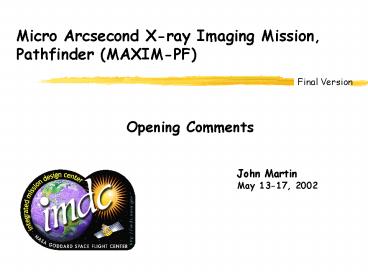John Martin - PowerPoint PPT Presentation
1 / 7
Title: John Martin
1
Micro Arcsecond X-ray Imaging Mission, Pathfinder
(MAXIM-PF)
Opening Comments
John Martin May 13-17, 2002
2
IMDC Study Goals
- Material which can be used as a basis for future
study by the MAXIM team - Each Discipline suggests future studies, building
on this weeks work - It may be only a small step from MAXIM Pathfinder
for the full MAXIM - Determine if it is reasonable to call this a 2015
launch - It is reasonable to do this, pending
authorization and sufficient money - Produce a life-cycle cost estimate
- Provided both as a grass-roots estimate and a
parametric estimate - Refine the mission profile (e.g., orbit analysis,
etc.) as contained in the prework and opening
presentation - Concepts for Phase 1 and Phase 2 have been
augmented and refined - Terms Mode 1 and Mode 2 have been used in
some places, but should be replaced with Phase
1 and Phase 2 in future work - Identify required technology miracles and
performance drivers - Miracles do not appear needed
- Technology developments needed for MAXIM are same
as needed for several other future missions
3
These are Included in our Standard Work Package
- Nice-looking mechanical diagrams, graphs and nice
sketches showing results of the study - Included in the Mechanical presentation and
supporting files - Graphs and other sketches
- Included in many Discipline presentations
- Disciplines cover these topics
- MAXIM requirements that drive the subsystem being
discussed - Subsystem configuration
- Elements included (could be components, but great
detail not expected) - Mass and cost estimates
- Technologies required
- Identify tall poles, if any (technology needed,
but not likely to be developed without funding or
other emphasis from MAXIM) - Identify items which are high cost in order to
meet the requirements - Tradeoffs performed or dead ends encountered
- Issues and items for future study
- Delivery CD-ROM will include all analyses done by
the IMDC this week - This presentation summarizes our work
4
MAXIM Information
- Following information in the LAI-MAXIM-PF Prework
folder - Prework, dated 10 April 2002 (Prework Report.htm)
- IMDC kickoff presentation on May 13, 2002 by
Keith Gendreau (going-in-13may02.ppt) - Information presented by Keith Gendreau to the
IMDC and ISAL team in February 2002
(PeriscopeDesignMAXIM.ppt) - Other background information files
- Material from recent ISAL studies are also
available - Files are on idcsvr3 in a folder called missions.
The ISAL studies that apply to LAI-MAXIM-PF are
LAI Beam Combo (M) and LAI Super Star Tracker. I
have mapped a network drive on my computer,
calling it drive N, making it quick and easy to
refer to these files - Our August 1999 MAXIM study is in the misdir
folder - This is a moderately future, (15 yrs to launch)
study of concepts and approaches design details
are important, but will probably be changed
before construction actually begins
5
Other Requested Trades or Studies
- TDRSS Support vs. direct to ground (for early
orbit?) - TDRSS often used for early orbit support of
Launch and Early Orbit - Use of a TDRSS-like relay from L2 vs. use of DSN
- TDRSS-like relay must be considered as a
synergistic requirement by several L2 missions - TDRSS development for use at L2 far exceeds DSN
cost for MAXIM
6
Requested Standard Products
- Spreadsheets, bullet charts, or other briefly
stated information useful to support ongoing
analysis of this potential mission - Information in the final presentation is a
summary of work done by the discipline engineers - System mass, power and cost spreadsheets, using
real data where available and typical data for
elements lacking specific information - Actual values for mass, power and cost are used
where known - Educated estimates used where specific data does
not extist - Cost estimated using both grass-roots and
parametric estimating methods - Files of supporting analysis (e.g., Excel
spreadsheets) - Included on final CD-ROM
- Power System Sizing
- Included in Power presentation
- Mechanical sketches of the detector, hub and
free-fliers in the launch shroud, in-transit to
L2,deployed for Phases 1 and 2 - Included in the Mechanical presentation
- Additional graphic files included on the CD-ROM
7
Analyses Show MAXIM to be an Advanced, but
Feasible Concept
- 100-105 Opening - John Martin
- 105-125 System Gabe Karpati
- 125-135 Flight Dynamics Steve Cooley
- 135-145 Mechanical Dave Peters
- 145-155 Thermal Wes Ousley
- 155-200 Launch Vehicle Larry Phillips
- 200-210 Attitude Control Eric Stoneking
- 210-220 Propulsion Bob Estes
- 220-230 Power Bob Beaman
- 230-240 Flight Software Kequan Luu
- 240-250 Data Systems Ron Vento
- 250-300 Mission Operations Tim Rykowski
- 300-310 Mission Success Dick Bolt
- 310-320 Parametric Cost Analysis Bill Lawson
- 320-330 Wrap-up - John Martin
8
Study Particulars
- Name
- Micro-Arcsecond X-ray Imaging Mission, Pathfinder
(MAXIM-PF) - MAXIM-PF_Discipline.ext used for discipline file
names - Dates
- May 13-17, 2002
- Primary Client Representatives
- Keith Gendreau, GSFC Code
- Kate Hartman, GSFC Code 490
- Webster Cash, Univ of Colorado
- Ann Shipley, Univ of Colorado
- Jim Leitch, Ball Aerospace
- Participants
- See the file MAXIM-PF_Attendance.xls
























![(PDF) The Naming of America: Martin Waldseemuller's 1507 World Map and the [PDF] PowerPoint PPT Presentation](https://s3.amazonaws.com/images.powershow.com/10119917.th0.jpg?_=20240904083)






